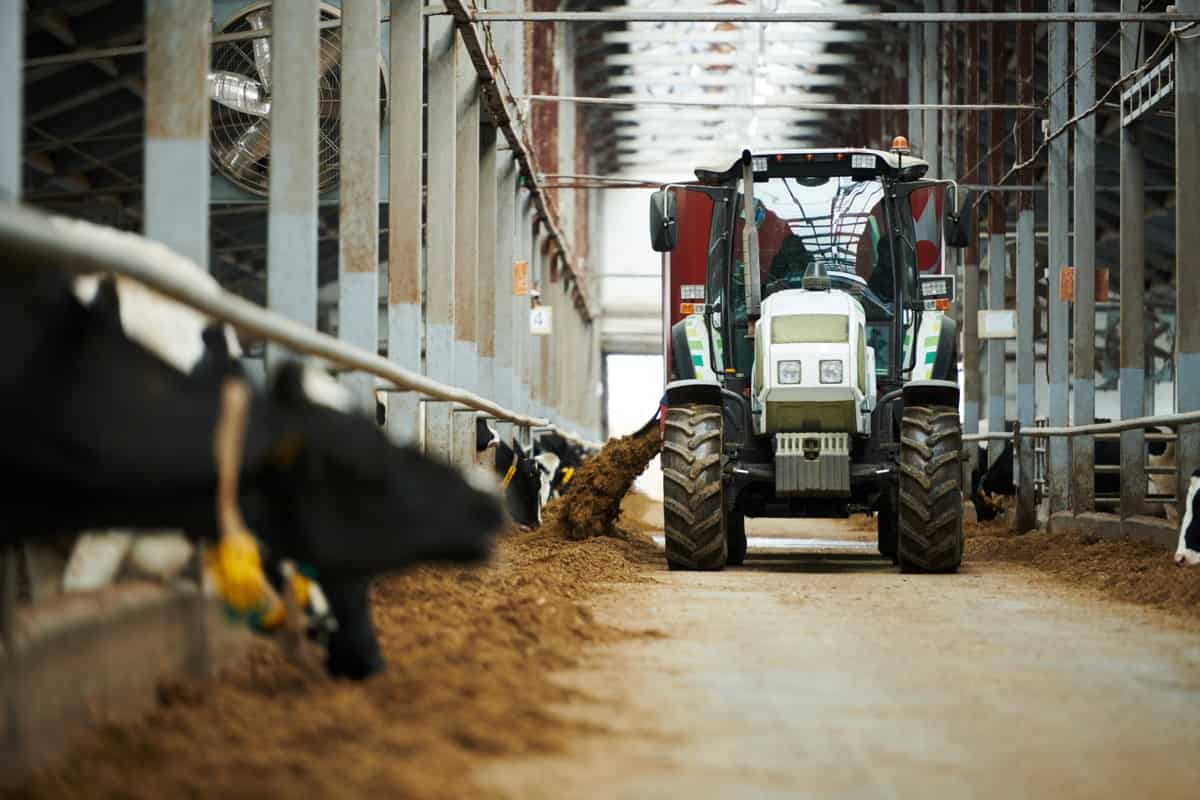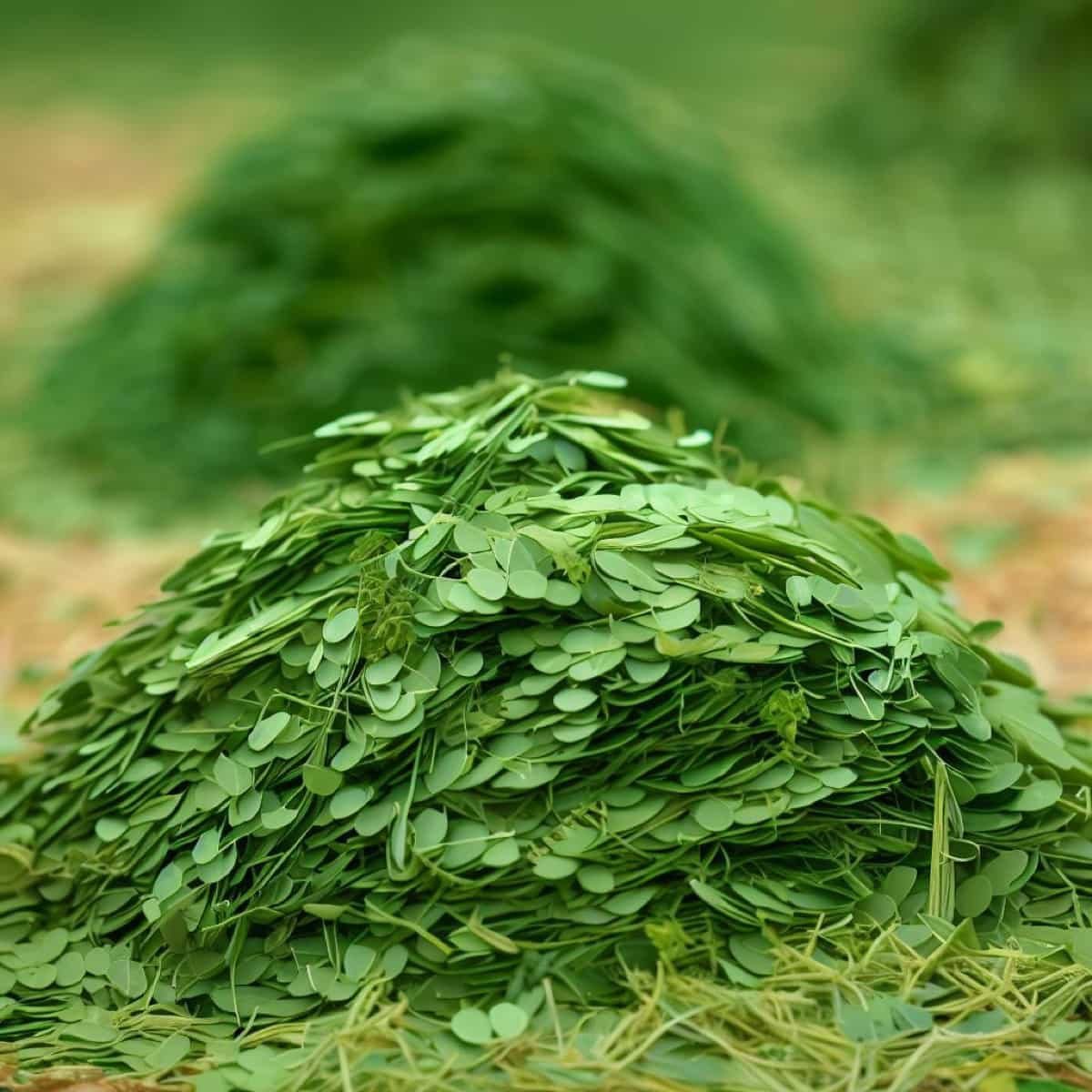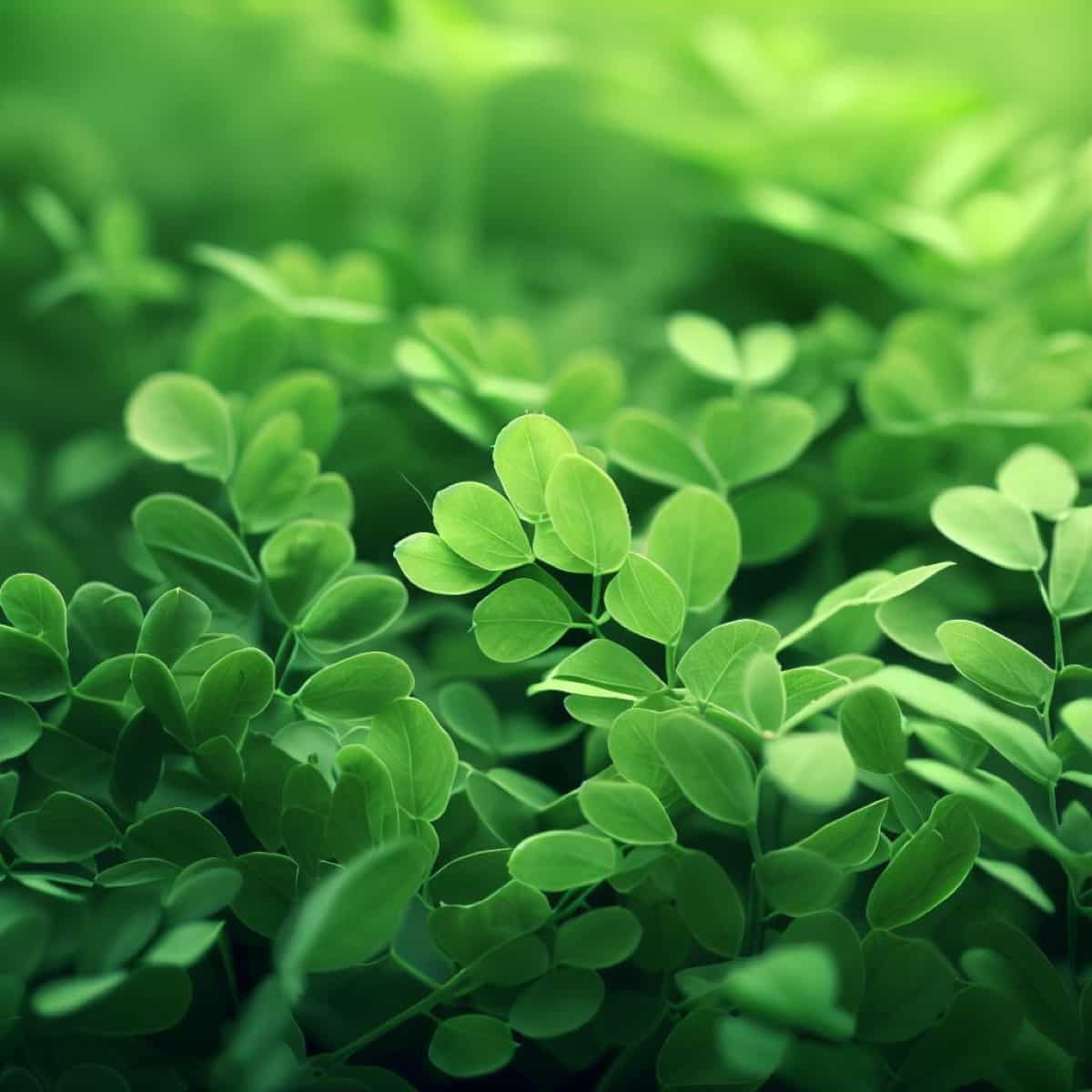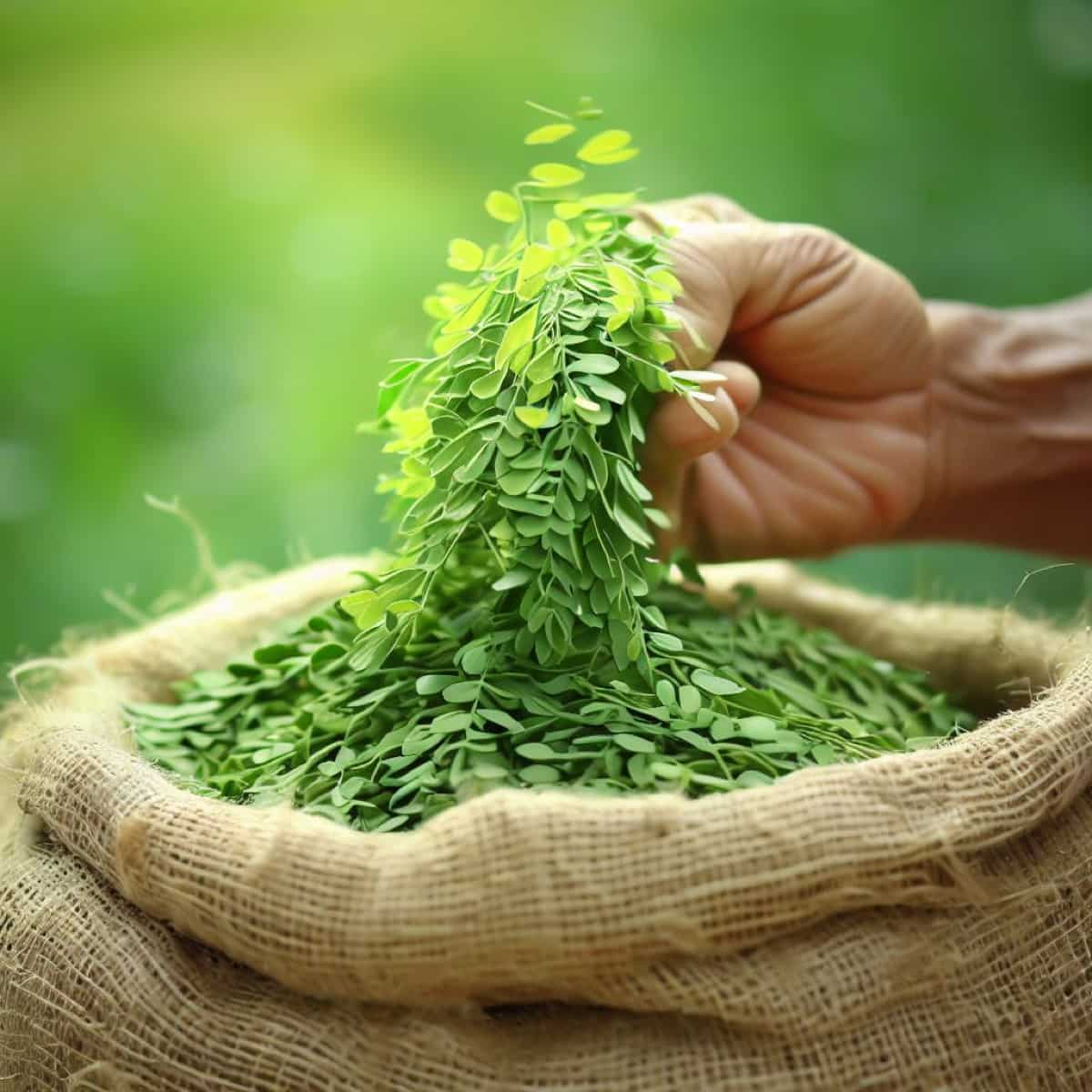Moringa, often called the “Miracle Tree,” is gaining recognition as a valuable fodder crop for livestock. Its remarkable nutritional profile makes it a promising choice for farmers seeking to boost animal health and productivity. In this blog, we’ll explore the impressive yield of Moringa fodder per acre and how it can benefit your livestock. We’ll also discuss the scientific aspects behind its nutrient-rich composition and its positive impact on animal growth.

Moringa as Feed for Livestock
What is Moringa Feed?
Moringa feed refers to using Moringa leaves, stems, and pods as a dietary supplement for livestock. Moringa, a fast-growing tree native to tropical regions, is renowned for its exceptional nutritional content. Its leaves are rich in protein and minerals, making it an excellent natural source of nutrition for animals. Moringa feed enhances their overall health, growth, and milk or egg production when incorporated into cattle, poultry, goats, and other livestock diets.
Nutritional Value of Moringa for Livestock
Moringa, originating in the sub-Himalayan regions of the Indian sub-continent, is a rapidly growing, evergreen to deciduous, medium-sized perennial tree, typically reaching heights of 10 to 12 meters. Its bark exhibits a whitish-grey hue and is enveloped by a substantial cork layer. Young shoots display purplish or greenish-white bark, while its flowers boast a yellowish creamy white color and emit a delightful fragrance.
The matured fruit is a pendant capsule, measuring 20-45 cm in size and containing 15 to 20 dark brown spherical seeds measuring 1 to 1.2 cm in diameter. Regarding nutrient composition, Moringa fodder proves to be a nutritional powerhouse for dairy animals. Beyond its protein and mineral content, it is an excellent source of pro-vitamin A, vitamin B, vitamins C & E, and certain carotenoids and sulfur-containing amino acids such as cysteine and methionine. When harvested as green fodder at 2 to 3-month intervals, Moringa crop contains:
| Dry Matter | 16.63% |
| Crude Protein | 15.82% |
| Ether Extract | 2.35% |
| Crude Fiber | 35.54% |
| Total Ash | 7.61% |
| Silica | 1.02% |
| Calcium | 0.80% |
| Phosphorus | 0.28% |
| Magnesium | 0.51% |
| Potassium | 1.43% |
| Sodium | 0.24% |
| Copper | 8.78 ppm |
| Zinc | 18.05 ppm |
| Manganese | 35.57 ppm |
| and Iron | 474.25 ppm |
In case you missed it: Pest and Disease Management in Moringa: Causes, Symptoms, Chemical, and Biological Control

Types of Moringa Used as Feed for Livestock
Various types of Moringa are employed as livestock feed, primarily in the form of green fodder. To make it suitable for consumption by dairy animals, Moringa green fodder is typically chopped into small pieces, approximately 2-3 cm in size, using manual or power chaff cutters. A daily ration of 15-20 kg of chopped Moringa green fodder can be mixed with dry or other cereal green fodder and provided to a single animal.
The advantages of utilizing Moringa as livestock feed are significant. First, Moringa is drought-tolerant, ensuring a consistent source of perennial fodder even in arid conditions. Furthermore, it boasts a rich nutritional profile, offering essential nutrients such as crude protein, minerals, and vitamins. Moringa can be propagated through both seeds and vegetative means, enhancing its accessibility for cultivation. Importantly, it serves a dual purpose, being consumed by humans and livestock, thus promoting sustainable resource utilization.
Factors Affecting Moringa Yield Per Acre
- Climatic Conditions: Moringa thrives in tropical and subtropical regions with well-distributed rainfall. It is sensitive to winter frost and cannot withstand extreme cold or waterlogged soils.
- Soil Quality: Well-drained, sandy loam soils rich in organic matter are ideal for Moringa cultivation. Soil pH should be 6.3 and 7.0 for optimal growth.
- Spacing and Plant Density: Proper spacing and plant density are critical. Typically, Moringa is planted 3 to 5 meters between rows and 2 to 3 meters between plants within rows.
- Pruning and Harvesting: Regular pruning of branches and harvesting of leaves promote bushier growth and higher yields. Leaves should be harvested before they become too mature and tough.
- Fertilization: Moringa benefits from organic and balanced mineral fertilization to meet nutrient requirements.
- Pest and Disease Management: Effective pest and disease control measures are crucial to prevent yield losses.
- Varietal Selection: Choosing high-yielding Moringa varieties suited to the local climate can significantly impact yield.
Benefits of Moringa for Animals
- Nutrient-Rich Feed: Moringa leaves are a powerhouse of essential nutrients, including protein, vitamins (A, B, C, and E), minerals (Calcium, phosphorus, magnesium, potassium), and amino acids. This nutrient-rich profile supports animal growth, health, and productivity.
- Improved Digestion: Moringa aids digestion due to its high fiber content, reducing animal digestive issues.
- Increased Milk and Egg Production: Livestock fed with Moringa often exhibit higher milk yields (in dairy cattle) and increased egg production (in poultry).
- Disease Resistance: Moringa’s natural antioxidants bolster animals’ immune systems, enhancing their disease resistance.
In case you missed it: Best Fertilizer for Moringa Plant: Organic, Compost Manure, NPK, and Schedule

Average Moringa Yield Per Acre
NDDB has also conducted Moringa spacing trials to determine the ideal spacing for fodder production. The results showed that the Moringa fodder crop sown at a 12 x 4 inches spacing yielded the highest green fodder and dry matter, with 53.72 t/ha and 12.44 t/ha, respectively. In contrast, spacing at 6 x 6 inches produced slightly lower yields, with green fodder and dry matter yields of 50.24 t/ha and 10.76 t/ha, respectively, over a 9-month cultivation period.
Promotion of Moringa as a Fodder Crop
Moringa (Moringa oleifera), commonly known as drumstick, sahjan, sujna, and other names, is a versatile tree cultivated for many purposes, including food, medicine, industrial applications, and fodder. When cultivated as a fodder crop, Moringa demonstrates remarkable potential in providing high-quality green fodder year-round for 4 to 5 years from a single piece of land.
Annually, Moringa can yield an impressive 100-120 tonnes of green fodder per hectare in 4 to 5 cuttings, sufficient to feed 18 to 20 animals within a mixed feeding system. The cultivation of Moringa can be carried out through various methods, including transplanting saplings and stem cuttings. Under field conditions, approximately 1 kg of Moringa seeds can yield around 2500 seedlings, facilitating its propagation.
Promoting Good Agricultural Practices (GAPs)
Enhancing Moringa’s yield and fodder production requires promoting good agricultural practices (GAPs). These practices aim to optimize seed yield and the overall cultivation process, ensuring high-quality green fodder. Disseminating knowledge about GAPs among farmers is essential for achieving these goals. Out of ten varieties, PKM-1, Bhagya, and Mysuru-Local were particularly promising for fodder production.
Moringa Feed Formulation for Livestock
Moringa feed formulation for livestock involves creating balanced diets that maximize Moringa’s nutritional benefits while meeting the animals’ specific dietary requirements. Nutrient composition, animal requirements, energy sources, protein complementarity, antinutritional factors, and feeding trials are essential for this goal. Understanding the precise nutrient content of Moringa leaves is crucial, as it is rich in protein, vitamins, minerals, and essential amino acids.
In case you missed it: Maximizing Milk Production: Dairy Cow Nutrition on Different Lactation Cycles

Different livestock species have varying nutritional needs, so formulas must meet these requirements. Energy sources like grains or forage should be included to meet energy demands. Moringa’s high protein content can complement diets with lower-quality forage or grains, enhancing overall protein intake.
Proper processing methods, such as drying and ensiling, can mitigate antinutritional factors. Balancing rations that meet protein, energy, fiber, and mineral requirements is essential, and feeding trials are vital to evaluate the acceptability and performance of Moringa-based diets. Cost-effectiveness is also crucial, as Moringa should be incorporated efficiently without significantly increasing production costs.
Moringa Processing and Preservation for Feed Use
Moringa is a valuable livestock feed source that requires careful processing and preservation to maintain its nutritional value. The process involves harvesting the leaves and pods at the right maturity stage, drying them to reduce moisture, chopping them into small pieces for easier handling, ensiling them with other forages to preserve their nutrients, and grinding them into fine powder for feed formulations.
Proper storage in a cool, dry place with pest protection is crucial for maintaining quality. Regular testing for nutrient content ensures that processed Moringa retains its nutritional value, providing valuable feed year-round. This ensures the preservation of Moringa’s nutritional value and its long-term availability.
Regulations and Standards for Moringa Feed for Livestock
- Chopping: The green biomass is first chopped into small pieces of approximately 1 inch using a chaff cutter.
- Drying: The chopped Moringa is sun-dried, which takes around 7-8 hours to convert into dry biomass. Sun-drying is commonly practiced, but there’s potential to explore machine-drying methods to avoid nutrient loss.
- Antifungal Properties: Moringa’s antifungal properties can prevent fungal growth even if the green biomass is left undried for 3 to 4 days, offering flexibility in the drying process.
In case you missed it: How to Make Corn Silage: Production and Management Steps for Goats, Sheep, Cows, Pigs, and Cattle

Moringa Fodder Cultivation Cost Per Acre
- Moringa Fodder: The cost of producing Moringa green fodder per acre is approximately Rs. 114,500 over three years. Moringa offers a higher green fodder yield, rich in minerals and quality amino acids, with a competitive crude protein yield similar to Lucerne. It is cost-effective compared to Lucerne and is less susceptible to pest infestations. Moringa can be grown on marginal lands across India and serve as a valuable feed for humans and livestock.
- Bajra Napier Hybrid Grass: This hybrid grass costs Rs. 135,800 per acre over three years, making it less cost-effective than Moringa. It offers a lower crude protein yield.
- Fodder Maize: Maize green fodder costs Rs. 103,100 per acre over three years, with moderate crude protein content.
- Perennial Lucerne: Lucerne cultivation costs Rs. 79,900 per acre over three years. Although it has a high crude protein yield, Lucerne is limited to fertile lands in western India.
Moringa as Goat Feed
Pelletized Moringa feed has proven to be an optimal choice for goat nutrition in trials conducted by CIRG in Mathura. Feeding goats with 1.5 to 2 kg of Moringa pellets daily over a year helps achieve a desired live body weight of 30 kg without additional concentrates or green fodder. Goats display a strong preference for Moringa pellets compared to other feeds.
The cost-effectiveness of Moringa pellets is remarkable, estimated at just Rs. 9-10 per animal per day (assuming 2 kg per adult at Rs. 4.5-5 per kg), as opposed to Rs. 15 per animal per day with traditional feeding methods. This substantial reduction in feed costs is critical for the viability of stall-fed goat rearing.
Furthermore, research findings reveal a significantly improved Feed Conversion Ratio (FCR) of 8.76:1 in goats fed with Moringa-based feed compared to 11.1:1 with other feeds. Field evaluations confirm a 25% reduction in feed costs and a 20% increase in milk yield, underscoring Moringa’s suitability and economic advantages as animal feed. A one-hectare Moringa cultivation can support approximately 150 Sirohi or 200 Barberi breed goats, highlighting its potential for sustainable and cost-efficient goat farming.
Moringa as Cattle Feed
Moringa serves as an excellent cattle feed due to its high nutritional content. Its leaves, rich in protein, vitamins, and minerals, enhance cattle health and milk production. Moringa’s antioxidant properties support the immune system, reducing disease susceptibility. It thrives in tropical regions, providing a consistent year-round fodder source. With proper processing, like drying and pelletizing, Moringa retains its nutrients for long-term storage. Its drought-resistant nature makes it a reliable option in arid areas.
Moringa as Pig Feed
Pig feed can incorporate dried and ground Moringa leaves containing high-quality protein, vitamins (A, C, E), minerals (Calcium, phosphorus), and essential amino acids. Scientifically formulated, Moringa-enhanced pig feed can improve growth rates, reproductive performance, and overall health. Typical inclusion rates range from 5-10% in pig diets. Beyond leaves, Moringa pods and seeds can be utilized.
Moringa as Sheep Feed
One effective method is to blend dried Moringa leaves into a powder and mix it with other feed components. Scientifically, Moringa is rich in protein, essential amino acids, vitamins (A, B, C, and E), and minerals. These nutrients enhance sheep’s health and wool quality. Its antiparasitic properties can help reduce worm infestations in sheep. Feeding guidelines typically suggest a daily intake of Moringa powder at 20-30 grams per sheep.
In case you missed it: Sustainable and Eco-friendly Strategies for Tick Control in Dairy Farming

Moringa as Poultry Feed
Thanks to its nutritional richness, Moringa is an excellent addition to poultry feed. It provides essential amino acids, vitamins (A, B, C, and E), minerals (calcium, phosphorus), and antioxidants that boost poultry health and productivity. Moringa in poultry feed can be sun-dried, ground into a powder, and incorporated into their diet. Scientific studies have shown that including Moringa in poultry feed can improve egg production, eggshell quality, and overall growth rates.
Conclusion
Moringa emerges as a promising fodder crop for livestock due to its high yields, rich nutrient profile, and adaptability. With the potential to produce over 100-120 tonnes of green fodder per acre, Moringa offers a cost-effective and sustainable solution for enhancing animal nutrition and supporting livestock farming.
- Types of Pesticides Used in Agriculture: A Beginner’s Guide
- Economical Aquaculture: A Guide to Low-Budget Fish Farming
- 15 Common Planting Errors That Can Doom Your Fruit Trees
- How to Make Houseplants Bushy: Effective Tips and Ideas
- Innovative Strategies for Boosting Coconut Pollination and Yield
- Pollination Strategies for Maximum Pumpkin Yield
- The Complete Guide to Chicken Fattening: Strategies for Maximum Growth
- Natural Solutions for Tulip Problems: 100% Effective Remedies for Leaf and Bulb-Related Issues
- Revolutionizing Citrus Preservation: Towards a Healthier, Greener Future